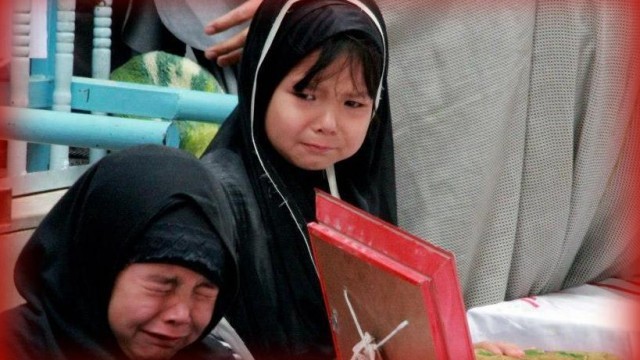
Lack of social integration remains a major reason for the Hazara alienation

Sadly, on October 23 eight people from the Hazara community were killed in the Hazar Gangi area of Quetta. The suicide attack in Quetta’s Hazara town on October 4 and the subsequent shooting in a mosque and a seminary on October 6 are all a grim reminder of how grave is the threat of religious extremism.
The issue of integration is a worldwide phenomenon. When it comes to Hazara integration in Quetta, lack of social integration remains a major reason for the Hazara alienation in Quetta. Misperception prospers in the absence of contact among the social groups. In the final analysis, social integration helps in healing the festering wound of social fragmentation.
The American heritage dictionary defines integration as "the bringing of people of different racial or ethnic groups into unrestricted and equal association, as in society or an organization."Integration has four types. These are political, economic, cultural and social. Politically the Hazara community in Quetta has its say in the decision making. With a population of an estimated 250,000 – 300,000 individuals as of 2011 in Quetta, the ethnic community has Syed Mohammad Raza--from Majlis Wahdat-ul-Muslemeen (MWM) -- in the 65 member provincial assembly.
Perhaps commensurate with their numbers, Hazaras are found in almost every government department. Culturally, the community shares more common values with Baloch and Pashtuns than is generally appreciated.
What then accounts for Hazara isolation?
The lack of contact with Baloch and Pashtun communities makes the Hazaras vulnerable to social isolation. While the Baloch and Pashtuns are Sunni, the Hazaras are Shia. Rarely do contacts cut across sectarian lines. In Quetta, Hazara town and Marriabad are almost exclusively Hazara populated localities. Only in the cantonment do Hazaras have either Pashtun or Baloch neighbours. Field visits aside, this is all the more obvious from the friend lists of social networking websites such as Facebook.
Also read: A segregated city
The spike in violence has further dwindled avenues for communities to socialise with one another. Worse, the communication gap is only widening. Cross ethnic and sectarian contacts were more common among the old generations than is the case with new generations. Before the intense bout of sectarian strife since 2003, Hazaras had a number of business outlets in various parts of Quetta city. Now their businesses are confined to Hazara town and Marriabad.
What are the impacts of contact gap?
Trust is the biggest casualty. The absence of awareness and knowledge of the Hazaras leads to stereotyping. The generalised view about the community is that they are monolithic and hard core Shia. In fact, the Hazara society is as divided as any other ethnic group on the question of religious identity and political affiliations. Perhaps the ratio of religiously neutral people are the highest in the community than is the case with any other ethnic group. Like other nationalists, Hazaras have secular, liberal and nationalist party, the Hazara Democratic Party. Imbued with nationalist fervour, the HDP takes pride in its Hazara identity.
Nevertheless, like any other ethnic group the Hazaras have their minority religious fringe. Stubbornly sectarian in orientation, they are Manichean by dividing the world into two opposite camps of "we versus they". Among the religious parties, MWM is the most popular. Of late, Pashtun khwa Milli Awami Party (PKMAP) has also made inroads into the Hazara society. In the 2013 general elections PKMAP’s Agha Muhammad Ali, himself a Hazara, contested for PB 2 (Quetta 2). Overall, the Hazaras, like general masses from other ethnic groups, are very moderate and friendly people.
Communication gap begets prejudice. Negative experiences in a case or two turn into a generalised opinion about the whole group. As a result, most people from all ethnic groups in Quetta value preconceived opinions that are never based on reason. This has only given way to harbouring derogatory stereotype. Once stigmatized, people rarely gain social acceptance. This leaves indelibly damaging effect on people’s ability to forge relationships with people who are different to them.
In Quetta, the Hazara are the avatar of ghetto community. This has had devastating effects on the community’s livelihood and vitality. Once a thriving lower middle class, the hard working Hazaras are off-limits to areas beyond their localities. This sad state of affairs has bred obsessive xenophobia on all sides only to give way to the predatory politics of scaremongers.
What is the way forward?
Cooperation, realists argue, is not possible in the absence of communication. Interaction is the way to foster trust among the communities. Intermingling helps us understand one another and nurture empathy. Howsoever different we may appear, we the teeming millions are more common in our aspiration for peace and tranquility. We will find that our multiple identities are conditioned by our social existence. We are either Hazara or Baloch or Pashtun because we were born to either a Hazara or Baloch or Pashtun father irrespective of our choice. In a similar way we are either Sunni or Shia just because we were either born to a Sunni or a Shia family.
What should the Hazara do?
It is a question of survival. Support the nationalist-cum-secular. The HDP is potentially best placed to take the charge of leading the Hazara youth. It shuns religious identity and loathes Iranian influence. Due to its secular credentials, the HDP has even acceptance among the hardcore Sunnis.
What about the government?
Prove your worth. In the short run, ensure security. Secondly, initiate dialogue among various religious and ethnic groups. In the long run, social integration through education should be a priority. The formative years of a young person often determines what their social networks will look like during adulthood. Syllabi should infuse diversity, compassion and respect for the difference. Our educational institutes need to be places where students from various ethnic, income and religious groups come together.
In a nutshell, strong social integration is a useful check on the toxic ideology of religious zealotry mixed with xenophobic subnationalism.